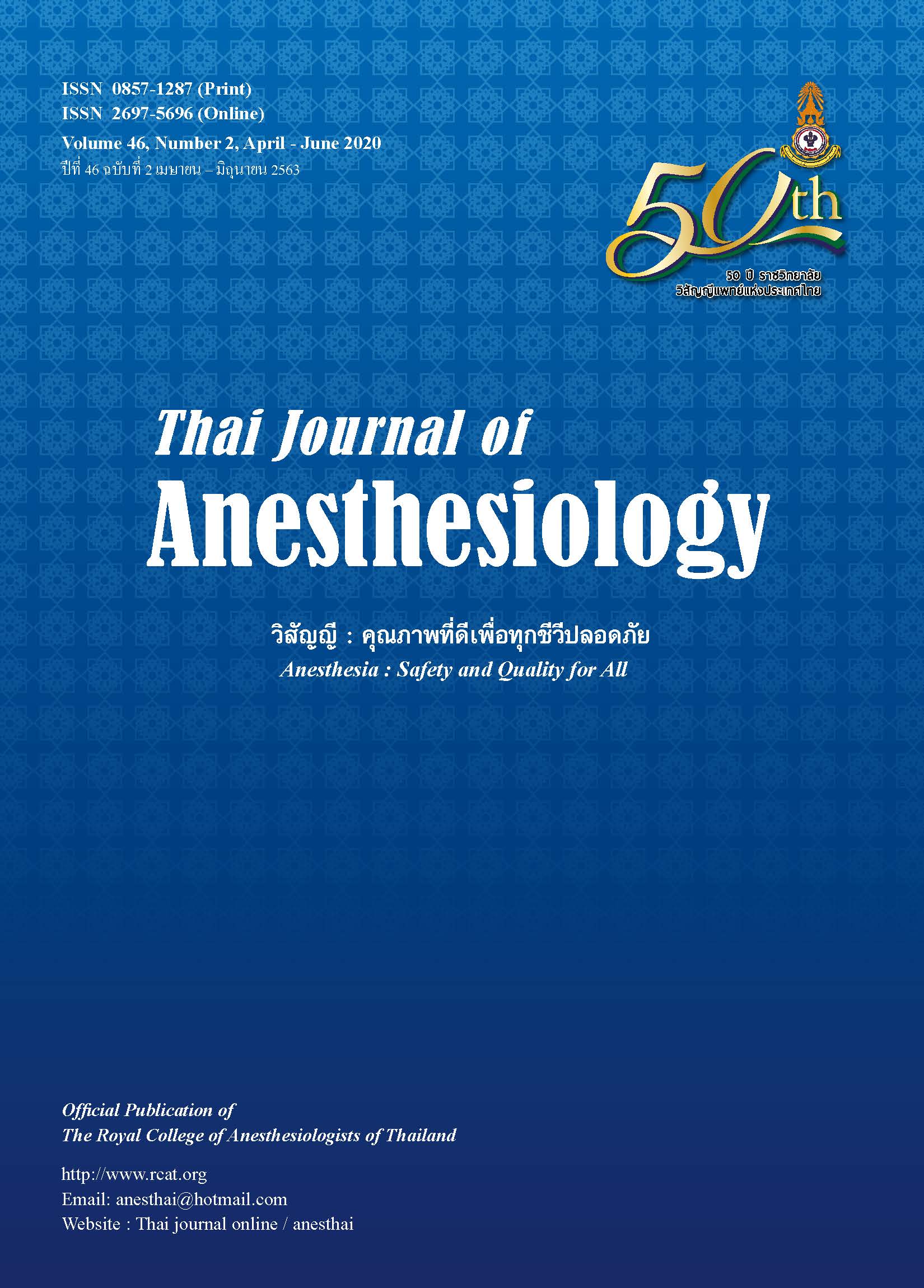A Comparison of Phenylephrine Administration between Intravenous Bolus and Slow Injection in Treatment of Spinal Anesthesia-Induced Hypotension on Bradycardia and Other Side Effects in Patients Undergoing Cesarean Section: A Randomized, Single-Blind Study
Main Article Content
Abstract
Background: Phenylephrine is currently recommended
for the management of spinal anesthesia-induced
hypotension due to fetal acid-base status improvement.
However, it induced bradycardia, which was a surrogate
outcome of cardiac output.
Objectives: To compare the incidence of bradycardia and
the other side effects between Intravenous (IV) bolus and
a slow injection of phenylephrine administration
Methods: One hundred and eighty-six parturients
undergoing elective cesarean section who had hypotension
following spinal anesthesia were randomized into two
groups. Group B received IV bolus injection of phenylephrine
100 mcg in 10 ml. Group S received continuous IV slow
injection of phenylephrine 100 mcg in 10 ml within 30
seconds with opening three ways of 3-way stopcock to
imitate the function of a syringe pump. Bradycardia was
treated with atropine 0.6 mg. The other side effects were
recorded.Results: The incidence of bradycardia was significantly
higher in group B than group S (9, 9.7% vs 1, 1.1%; P = 0.009).
All bradycardia in Group B had heart rate 46-60 bpm with
hypotension and no associated with pressing on the
fundus to assist in the birth (uterine compression). But,
one case in Group S had heart rate < 45 bpm, which
related to uterine compression. There was no statistically
significant difference in the total dose of phenylephrine
administration, reactive hypertension, cardiac arrhythmia,
neonatal Apgar score at 1 and 5 minutes, and birth weight
between two groups.
Conclusions: Slow injection of phenylephrine within
30 seconds to imitate the function of a syringe pump can
significantly lower the incidence of phenylephrine-induced
bradycardia than bolus injection in the treatment of spinal
anesthesia-induced hypotension.
Article Details
References
Incidence and risk factors of hypotension and bradycardia
after spinal anesthesia for cesarean section. J Med Assoc
Thai 2008;91(2):181-7.
2. Saravanan S, Kocarev M, Wilson RC, et al. Equivalent dose
of ephedrine and phenylephrine in the prevention of postspinal
hypotension in Caesarean section. Br J Anaesth
2006;96(1):95-9.
3. Cyna AM, Andrew M, Emmett RS, et al. Techniques for
preventing hypotension during spinal anaesthesia for
caesarean section. Cochrane Database Syst Rev 2006(4);
CD002251.
American Society of Anesthesiologists Task Force on
Obstetric Anesthesia. Practice guidelines for obstetric
anesthesia: an updated report by the American Society of
Anesthesiologists Task Force on Obstetric Anesthesia.
Anesthesiology 2007;106(4):843-63.
5. Kinsella SM, Carvalho B, Dyer RA, et al. International
consensus statement on the management of hypotension
with vasopressors during caesarean section under spinal
anaesthesia. Anaesthesia 2018;73(1):71-92.
6. Anusorntanawat R, Uerpairojkit K, Thongthaweeporn N, et al.
Safety of Phenylephrine in Antihypotensive Treatment during
Spinal Anesthesia for Cesarean Section. J Med Assoc Thai
2016;99(2):188-96.
7. Sharwood-Smith G, Drummond GB. Hypotension in obstetric
spinal anaesthesia: a lesson from pre-eclampsia. Br J
Anaesth 2009;102(3):291-4.
8. Langesaeter E, Rosseland LA, Stubhaug A. Continuous
invasive blood pressure and cardiac output monitoring
during cesarean delivery: a randomized, double-blind
comparison of low-dose versus high-dose spinal anesthesia
with intravenous phenylephrine or placebo infusion.
Anesthesiology 2008;109(5):856-63.
9. Lee JE, George RB, Habib AS. Spinal-induced hypotension:
Incidence, mechanisms, prophylaxis, and management:
Summarizing 20 years of research. Best Pract Res Clin
Anaesthesiol 2017;31(1):57-68.
10. Thomas D, Kiehn J, Katus HA, et al. Adrenergic regulation
of the rapid component of the cardiac delayed rectifier
potassium current, I(Kr), and the underlying hERG ion
channel. Basic Res Cardiol 2004;99(4):279-87.
11. Farkas A, Dempster J, Coker SJ. Importance of vagally
mediated bradycardia for the induction of torsade de pointes
in an in vivo model. Br J Pharmacol 2008;154(5):958-70.
12. Siddik-Sayyid SM, Taha SK, Kanazi GE, et al. A randomized
controlled trial of variable rate phenylephrine infusion with
rescue phenylephrine boluses versus rescue boluses alone
on physician interventions during spinal anesthesia for
elective cesarean delivery. Anesth Analg 2014;118(3):611-8.
13. Mohta M, Harisinghani P, Sethi AK, et al. Effect of different
phenylephrine bolus doses for treatment of hypotension
during spinal anaesthesia in patients undergoing elective
caesarean section. Anaesth Intensive Care 2015;43(1):74-80.
14. Stewart A, Fernando R, McDonald S, et al. The dose-dependent
effects of phenylephrine for elective cesarean delivery under
spinal anesthesia. Anesth Analg 2010;111(5):1230-7.
15. National drug information [Internet]. [cited 2019 Aug 27].
Available from: http://ndi.fda.moph.go.th/drug_detail/index/
?ndrug=5&rctype=1C&rcno=6215031&lpvncd=&lcntpcd=
&lcnno=&licensee_no=


